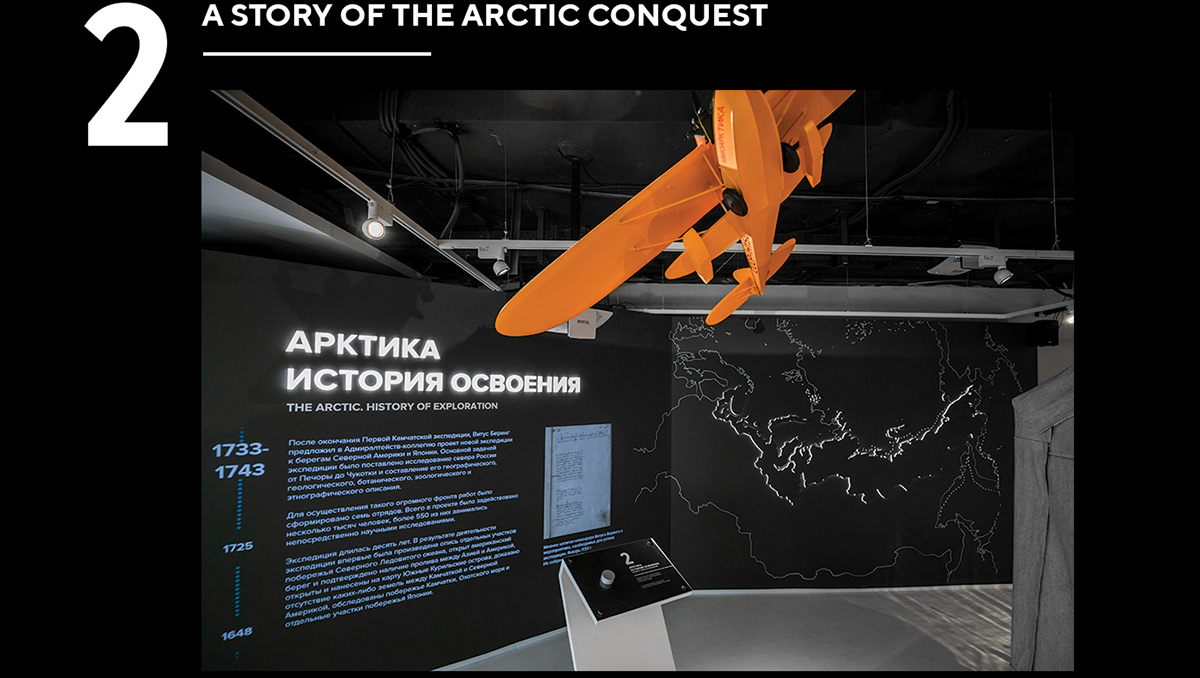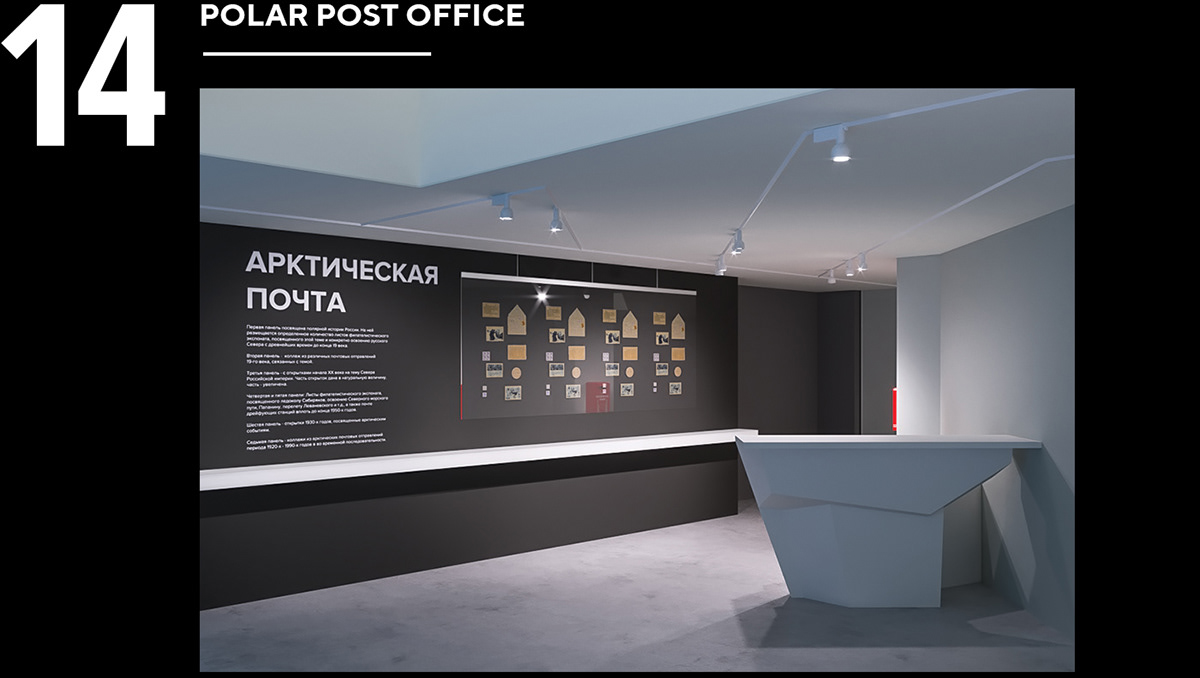
‘The Russian Arctic’ exhibition, on display from September 18, 2017 to February 18, 2018, was timed to the opening
of the Media Center in the Zaryadye Park, Moscow and was the first one that took place there. We were tasked
with the whole cycle of works: from conceptual design elaboration, architectural and multimedia design to production
of all the audiovisual and interactive contents, manufacturing of display cases and stage props, and installation
of the exhibition. We also designed the exhibition’s logo and visual identity, planned the integrated graphic design, conducted research, and created the tour programs for children and adults.
We used integrated architectural, light and interior design solutions to divide the exhibition space into thematic zones, dedicated to the history, culture and art, the natural world of the Arctic and the future of its exploration. Each zone contained a key multimedia exhibit, as well as a number of installations on the subject matter.


Our conception was based around the main idea to place visitors’ route between kind of icebergs and ice hummocks making it more dramatic experience — a journey full of unexpected twists and turns around the key installations —
from the first one, ‘Tent of the Papanin Team’ via ‘Northern Lights’ and to the last one, ‘Northern Sea Route’.



An interactive projection installation named ‘A Story of the Arctic Conquest’ displayed key dates from ancient
of the exploration of Russian polar region. A visitor could select a certain period from ancient times to nowadays
and see relevant information and rare illustrations from State Historical Museum and Russian Navy Archive displayed.



The Arctic theme as the stylistic dominant of the concept was objectified by using built-in glass cases for the exhibits. Inside this glass cases we placed unique objects such as scientific and exploration instruments from the early XXth century. Other interior elements, for example benches, tables and remote desks for the interactive installations were also designed according to the exhibition theme.

In the zone dedicated to lifestyle of nomadic Northern peoples of Russia, we placed an exact replica of yaranga
(a tent-like traditional mobile home of some nomadic Northern indigenous peoples of Russia) made by artisans
from polar region. Inside yaranga visitors could have seen some documentaries about life of polar area inhabitants
and modern arctic region research. Next to it on the wall we placed real paintings and drawings of polar artists provided to us by our client - ROSIZO.



For the little visitors of the exhibition we designed and set aside a dedicated edutainment zone that included
a range of activities: from workshops, educational puzzles and thematic Eskimo Lego sets to thematic cartoons
and coloring papers with implemented augmented reality (AR) markers. Also in the children's area were shown thematic cartoons and educational workshops were planned.



In the ‘Northern Lights ‘zone we have created a unique engineering multimedia solution: with the help of more
than 1 300 LED devices and projection of video content on the holographic film, the aurora borealis effect was created against the night sky with twinkling and falling stars. A prominent electronic musician Alexey Devyanin aka Pixelord wrote music for this installation. Due to custom design and set-up solution, the whole installation had looked naturally even from a very close distance. On the wall, adjacent to the huge holographic screen wall an animation film
about aurora borealis was shown. Nearby this installation stood an original exhibit — an original milepost
from a Russian Geographical Society polar expedition, demonstrating the distances from geographic North pole
to different cities of the world, which became a popular selfie-spot for our visitors.



Installation ‘Sounds of Animals’ displayed photo of 10 Arctic animals and some information about them and also played their voices. This installation was interactive so visitors could choose an animal to watch and to listen to.




For the installation ‘Arctic Wildlife’ we had made 3D models of walrus, polar wolf and white bear and produced realistic models using laser cutting and airbrushing. Behind these real-sized models, visitors could see projection
of their animated shadows, showing how these animals behave in their natural habitat.







One of the most important and spectacular installations became ‘The Northern Sea Route’, for which we used projection video mapping technology, using which an animated content was displayed over bas-relief of the newest Russian nuclear icebreaker from Leader series. The animated content reflected its design features and was accompanied
by a story about the Northern sea route and its importance for the development of the economy of the Northern regions. In front of this installation there is an exhibition with photos from the life of the Russian Arctic, made by modern photographers.

At the end of the exhibition route visitors encountered the last part of the exhibition — ‘Polar Post Office’. Traditionally,
all polar expeditions have their own post office, so we decided to print exhibition-themed postcards. Each visitor could send such card, stamped with the logo of the exhibition, so after the exhibition few thousands of postcards dedicated
to the exhibition were delivered across Russia.







